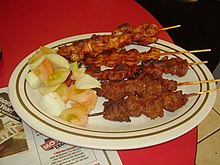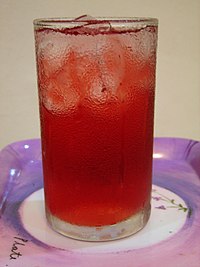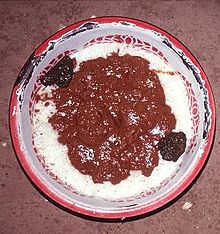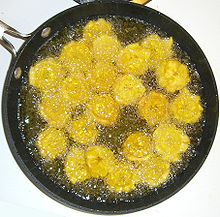Rice-Based
- Coconut rice is a rice dish made with coconut milk.
- Jollof rice is a rice-based food, made up with a range of spices, tomatoes, onions, and various seafood. It is a major delicacy served in most parties, events and occasions in Nigeria.
- Fried rice is a rice dish typically mixed with an assortment of eggs, vegetables and meat, poultry or prawns.
- Pate is made with ground dry corn, rice or acha. Mostly combined with vegetables (spinach), tomatoes, onions, peppers, garden eggs, locust beans, groundnuts, biscuit bones and minced meat. It is common within northwestern Nigeria, like Kaduna, Nassarawa and Plateau.
- Tuwo masara is a corn flour dish eaten in the northern part of Nigeria.
- Tuwo shinkafa is a thick rice pudding usually eaten with "miyan kuka" (a mucilaginous soup) and goat meat stew or miyan taushe, a pumpkin stew made with spinach, meat (usually goat or mutton) and smoked fish. It is primarily served in the northern part of the country.
Bean-based
- Akara
- Ewa Agoyin
- Gbegiri (a bean based stew native to southwest Nigeria)
- Moin moin
- Ekuru
 Meat
Meat
Meat is used in most Nigerian dishes.- Suya is grilled meat coated with ground chili pepper, peanut powder, and other local spices. It is prepared barbecue-style on a stick. This is one of the most famous Nigerian delicacies and can be found within easy reach all over the country.
- Tsire refers specifically to meat which has a generous coating of peanut/chili powder. It may or may not be on a skewer.
- Kilishi is made from meat that has been cut into very thin slices which is then spread out to dry. A special preparation of chili pepper, spices and local herbs is then prepared into a paste which is lightly brushed on both sides. This is then briefly grilled.
- Balangu refers to meat that has been grilled over wood/coal fire. Specifically, no seasoning is applied to bring out the natural flavor of the particular type of meat which may be goat, sheep or cow meat. Salt and spices can be added later according to taste.
- Nkwobi Cooked cow legs smothered in a thick, spicy sauce. This is a classic dish originating from the South-Eastern region in Nigeria.
Soups and stews
- Banga soup is made from palm nuts and is eaten primarily in the southern and midwestern[citation needed] part of Nigeria.
- Miyan kuka is very common among the Hausa people.
- Miyan yakuwa is a famous soup common among the Hausa people.
- Ayamase is a stew made by blending several green or red scotch bonnets/peppers.
- Ewedu
- Ewa Agoyin
- Edikaikong
- Gbegiri is a bean based stew native to southwest Nigeria.
- Pepper soup is a light soup made from a mix of meat and fish with a mix of herbs and spices. This is one of the few soups in Nigerian cuisine that can be drunk alone and not used as a sauce for a carbohydrate main dish such as fufu or pounded yam.
- Afang is a vegetable soup which has its origin from the Efik people in the southeast of Nigeria.
- Corn soup, also known locally as omi ukpoka, is made with ground dry corn and blended with smoked fish. It is common with Afemai people mainly from Agenebode in northern Edo state.
- Draw soup (or okoroenyeribe) is made from okra or melon seeds cooked until they thicken.
- Efo riro is a stew made from leafy vegetables and tastes nice when eaten with fish. It is common among the Yorubas.
- Egusi soup is thickened with ground melon seeds and contains leafy vegetables, other vegetables, seasonings, and meat. It is often eaten with dishes like amala, pounded yam (iyan), fufu, etc.
- Maafe, groundnut stew made with groundnuts (peanuts), tomatoes and onions as the base, and can be infinitely varied with chicken, beef or fish and different leafy vegetables for subtle flavours. Groundnut stew is made with ground dry groundnuts and vegetables, fish, meat, local seasoning and palm oil. It is common amongst Etsakor people in Edo state.
- Rice stew, similar to Maafe, is a stew made from goat, beef or chicken and cooked with a tomato, onion, pepper and groundnut sauce.
- Ogbono soup is made with ground ogbono seeds, with leafy greens, other vegetables, seasonings, and meat. Ogbono is also eaten with many dishes similar to pounded yam, amala, fufu, etc.
- White soup is made with Utazi leaves. The soup is not necessarily white, hence its name.
- Peppersoup is made with nutmeg and chilly pepper. It can be garnished with any of fish, beef, goat meat or chicken. Peppersoup is usually used as appetizer in official gatherings however, it is consumed majorly in the evenings at pubs and social gathering.
- Bitterleaf Soup (Ofe Onugbu)
- Groundnut Soup (Peanut Soup)
- Ora (Oha) Soup
- Edo Esan (Black Soup)
- Ofe Owerri
Side dishes
Dodo (Fried plantain)
- Dodo (Fried Plantain) is a side dish of plantains fried in vegetable oil or palm oil. It is preferably ripe plantain.
- Funkaso, millet pancakes
- Mosa, fermented corn, which is ground into a thick paste, fried and then sprinkled with sugar. It is an acquired taste. There is also an alternative form made from very soft plantain which is mashed into a paste, mixed with dried black pepper, fried and then sprinkled with sugar, for those with a sweet tooth.
Puddings, pastes and porridges
- Moin moin is a savoury steamed bean pudding made from a mixture of peeled black-eyed beans and wrapped in a leaf (like a banana leaf).
Yam-based
A Plate of Pounded Yam (Iyan) and Egusi Soup.
- Iyan, called pounded yam in English, is similar to mashed potatoes but all mashed and completely smooth with no yam chunks left.
- Amala (or aririguzofranca) is a thick paste made from yam, which has been peeled, cleaned, dried and then blended similar to iyan but normally darker (brown) in colour.
- Asaro, also known as yam porridge, is a popular Nigerian dish common in the western region. It is made by boiling and lightly mashing yam in rich tomato, chili and big red pepper sauce with palm oil or vegetable oil. It can be garnished with fish, meat or crayfish as desired.
Cassava-based
- Eba, also called gari, is a very thick paste that is either rolled into balls or served like amala, and made from cassava (manioc).
- Fufu, a staple dish in Nigeria and most of West Africa.
- Lafun is basically like amala but much lighter in colour, and made from cassava. It is not to be confused with iyan, but tastes and smells totally different from the yam-based "iyan".
Breakfast
- Masa is made from rice which is soaked and then ground. The thick paste is then poured into clay forms. The clay forms have a heat source from beneath. A spatula is used to flip it over by gouging it out of the form. It is traditionally served with miyan taushe.
- Sinasir is a flat masa, nowadays simply made by pouring the prepared rice paste into a frying pan, thus avoiding the need to flip it over as will be necessary for normal masa.
- Yams with red stew or scrambled eggs with diced tomato and onion.
- Ogi/Akamu
Snacks
- Chin Chin are best described as fried cookies made from wheat flour, eggs and butter.
- Puff Puff, fried sweet dough balls
- Akara is a beignet from a dough based on black-eyed beans. It is sometimes served for breakfast.
- Alkaki, made from wheat and sugar paste
- Kuli-Kuli, made from ground peanuts.
- Kokoro is a fried dry snack made from corn and garri (cassava). There are two different kinds.
- Meat pie, beef and vegetables enclosed in a pastry case.
- Wara, soft cottage cheese made from fresh cow milk.
- Plantain chips
- Coconut candy
- Dun Dun, roasted or deep-fried slices of yam. It may be fried in palm oil or vegetable oil; water is added to soften the yam as it cooks. Dun Dun is usually eaten with a sauce made of groundnut or palm oil, tomatoes, chili peppers and seasoning.[citation needed]
 |
| Zobo |
Beverages
- Kunu is a popular drink made of either millet, sorghum or maize.
- Fura da Nono is a popular drink especially across northern Nigeria, made of cooked then pounded millet or sorghum with some cow's milk.
- Palm wine, which may be distilled into ogogoro.
- Zobo is a drink made of roselle juice (the Yorubas call the white variety Isapa)
- Soya bean milk is a drink made from soaked, ground, and sieved soya bean seeds
See also
References
| This article needs additional citations for verification. (October 2009) |
- H.O. Anthonio & M. Isoun: "Nigerian Cookbook." Macmillan, Lagos, 1982.
- Fowora, Simbo. "Jollof Rice". FoodNetwork. Retrieved January 2015.
- Hudgens, Jim (2004). Rough Guide to West Africa. City: Rough Guides Limited. p. 1007. ISBN 1-84353-118-6.




No comments:
Post a Comment